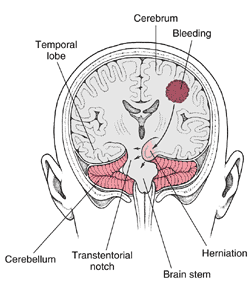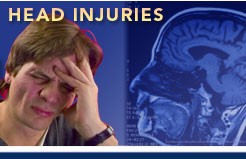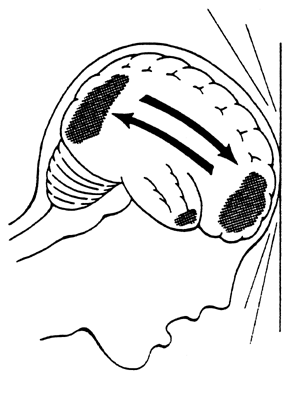




 |
 |
 |
 |
 |
Introduction
When a cartoon character gets bonked on the head, stars appear and float in a silly circle. It may be funny to see in a cartoon, but it's not so funny when it happens for real. Seeing stars, feeling goofy or dazed for a little while, or being knocked out after getting hit in the head are all symptoms of a type of brain injury called a concussion.
All head injuries are potentially serious and require proper assessment because they can result in impaired consciousness. Injuries may be associated with damage to the brain tissue or to blood vessels inside the skull, or with a skull fracture.
A head injury may produce concussion, which is a brief period of unconsciousness followed by complete recovery. Some head injuries may produce compression of the brain (cerebral compression), which is life-threatening. It is therefore important to be able to recognize possible signs of cerebral compression - in particular, a deteriorating level of response.
A head wound should alert you to the risk of deeper, underlying damage, such as a skull fracture, which may be serious. Bleeding inside the skull may also occur and lead to compression. Clear fluid or watery blood leaking from the ear or nose are signs of serious injury.
Any person with an injury to the head should be assumed to have a neck (spinal) injury as well and be treated accordingly.
The brain is free to move a little within the skull, and can thus be "shaken" by a blow to the head. This shaking is called concussion.
Among the common causes of concussion are traffic incidents, sports injuries, falls, and blows received in fights.
Concussion produces widespread but temporary disturbance of normal brain activity. However, it is not usually associated with any lasting damage to the brain. The person will suffer impaired consciousness, but this only lasts for a short time (usually only a few minutes) and is followed by a full recovery. By definition, concussion can only be confidently diagnosed once the person has completely recovered.
A person who has been involved in a concussion should be monitored and advised to obtain medical aid if symptoms such as headache or blurred vision develop later.
Warning: if the person does not recover fully, OR if there is a deteriorating level of response after an initial recovery Dial 911 for an ambulance.
Disclaimer: This information is not intended be a substitute for professional medical advice. It is provided for educational purposes only. You assume full responsibility for how you choose to use this information.
What Is a Concussion?
The brain is made up of soft tissue and it's cushioned by blood and spinal fluid. When someone gets a blow to the head or his or her head hits something very hard, the brain suddenly shifts inside the skull and can knock against the skull's bony surface. Sometimes this can happen with a lot of force. A concussion is a temporary change in the way the brain works when it is suddenly moved or jarred in this way.
Sometimes, concussions last just a few moments. Other times, a person can be unconscious (knocked out or passed out) for a couple of minutes or longer from a concussion. But even concussions that seem to last just a few moments can be serious.
Every year, serious brain injuries send more than 400,000 kids to the emergency department. Injuries from car crashes, playgrounds, or sports are the most common ways that kids get concussions.
Severe concussions can happen after a bad blow to the head, like from a bad bike accident or a car crash. A severe concussion is a medical emergency. The person will need to go to the hospital right away. If the brain is seriously injured, a person could have long-lasting problems with movement, learning, or speaking.
But most of the time, after a mild head injury, people return to normal, even if the injury caused a concussion. But getting more than one concussion can lead to more serious problems. You may have heard of football players and boxers who have medical problems because of repeated concussions.
What Happens When Someone Gets a Concussion?
How a person acts after a concussion depends upon how forcefully the brain was jarred inside of the head. Sometimes a person loses consciousness, or is knocked out, for a few seconds or minutes.
A person may have a milder concussion and not be knocked out. Despite being awake, some people might have amnesia and may be unable to remember what happened right before the head injury - or what happened immediately afterward.
Most people who have a concussion will feel groggy and dazed for at least a little while. They may feel like they are in a fog. They may be shaky or dizzy if they try to walk or do normal activities right away. Some people feel nauseated (sick to their stomachs) or may even throw up right after a concussion. Many people will have a mild headache that lasts for a few days or longer.
Sometimes, with a severe concussion, there may be bleeding inside of the head or bruising of the delicate brain. Usually someone with a bad head injury will have symptoms of a moderate or severe concussion - such as being knocked out for longer than a few minutes, acting very confused (unable to remember the names of people or places, and sometimes even their own name), vomiting repeatedly, or having a bad headache.
What Will the Doctor Do?
Anyone with a head injury - especially kids - should get checked by a doctor. If someone has a loss of consciousness, he or she should get immediate care in the emergency department as soon as possible.
Doctors get many clues about a possible concussion just by talking to someone who has had a head injury. If that person was knocked unconscious or cannot remember the injury, then a concussion is very likely.
If a doctor suspects that someone may have a concussion, he or she will perform a complete examination. The doctor may ask some questions that seem silly, like if the person knows what his or her name is, where he or she is, or what day of the week it is - doctors may even ask the name of the current president of the United States! These questions serve an important purpose - to check someone's memory and ability to concentrate.
The doctor will also examine a person who may have a concussion by looking into the eyes and checking reflexes and balance. Sometimes the person who had the injury may even be asked to do an activity such as moving around or running in place for a few minutes to see how well the brain functions after a physical workout.
A CT scan (a special three-dimensional brain X-ray) is sometimes ordered to make sure there is no bleeding or bruising inside someone's head after a concussion, especially if the person lost consciousness or is feeling very sick in the emergency department.
When a kid is released from the hospital soon after a concussion, the doctor will give the parent a list of instructions to follow. Parents may be asked to wake the child once or twice during the night to check on how he or she is doing.
Playing Sports Again
Anyone with a concussion will need extra rest during the next few days or weeks. The person also may need to take it easy at school. The doctor will tell the kid to wait a certain amount of time before returning to sports and other activities. A kid needs to wait a while after a concussion because if he or she would get another concussion, it could harm the brain more seriously. Then the kid would have to wait even longer to get back to sports and other activities.
Healthy kids can usually resume their normal activities within a few weeks or months, but each kid and situation is different. A kid's doctor will want to do a checkup before letting him or her return to soccer, hockey, or football.
A person who has had a concussion and is still having symptoms for weeks to months is said to have postconcussion syndrome (PCS). Someone with PCS may have the same symptoms as someone with a regular concussion - such as poor memory, headaches, dizziness, and irritability - but these last for longer periods of time. Anyone who has continuing problems after a concussion needs to see the doctor.
Can Concussions Be Prevented?
Injuries happen. But the best way to prevent a concussion is by taking care of your head. Here's how:
See what we're saying? If you use your head, you can protect your head!
Disclaimer: This information is not intended be a substitute for professional medical advice. It is provided for educational purposes only. You assume full responsibility for how you choose to use this information.
Head Injuries
Head injuries fall into two categories: external (usually scalp) injuries and internal head injuries, which may involve the skull, the blood vessels within the skull, or the brain.
Fortunately, most childhood falls or blows to the head result in injury to the scalp only, which is usually more frightening than threatening. An internal head injury could have more serious implications because the skull serves as the protective helmet for the delicate brain.
External (Scalp) Injury
The scalp is rich with blood vessels, so even a minor cut to the scalp can bleed profusely. The "goose egg" or swelling that may appear on the scalp after a head blow results from the scalp's veins leaking fluid or blood into (and under) the scalp. It may take days or even weeks to disappear.
What to look for and what to do:
Suspected Internal Injury
The brain is cushioned by cerebrospinal fluid, but a severe blow to the head may knock the brain into the side of the skull or tear blood vessels. Any internal head injury - fractured skull, torn blood vessels, or damage to the brain itself - can be serious and possibly life threatening.
There are different levels of injury that require different levels of concern. It can be difficult to determine the level of injury, so it's always wise to discuss a head injury with your child's doctor. A clear indicator of a more serious injury is when your child loses consciousness or has signs of confusion.
What to look for and what to do:
Call an ambulance if your child shows any of the following symptoms:
If your child is unconscious:
If your child is conscious:
Concussions are also considered a type of internal head injury. A concussion is the temporary loss of normal brain function as a result of an injury. Repeated concussions can result in permanent injury to the brain. One of the most common reasons kids get concussions is through sports, so it's important to make sure they wear appropriate protective gear and don't continue to play if they've had a head injury. However, it's possible to get a concussion that's mild and just requires observation.
If your child sustains an injury to the head, watch for the following signs that indicate that he or she may have a concussion:
If you suspect a concussion, call your child's doctor for further instructions.
Preventing Head Injuries
It's impossible to prevent your child from ever being injured, but there are some things you can do to help keep blows to the head at bay. Make sure:
Disclaimer: This information is not intended be a substitute for professional medical advice. It is provided for educational purposes only. You assume full responsibility for how you choose to use this information.
Updated and reviewed by: Barbara P. Homeier, MD
Date reviewed: December 2004
Originally reviewed by: Kathleen M. Cronan, MD